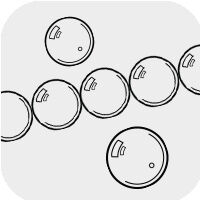Seraphinite
Meaning and Properties
Seraphinite History
Seraphinite (pronounced sair-uh-FEEN-ite) is a trade name for a particular form of silicate mineral called a clinochlore. Clinochlores get their name from the Greek word chloros (meaning "green"), in reference to their base color, not their chemical makeup. Another trade name for this stone is serafina.
The two trade names come from the stone's appearance: it has chatoyant inclusions resembling feathers (specifically, the feathers of the seraphim, a class of biblical angels). Individual stones showcase the chatoyant inclusions to varying levels of strength.
Its discovery and identification is typically assigned to Russian mineralogist Nickolay Koksharov. This finely grained stone is commonly used for carving and as a décor element for high-end professional spaces.
Seraphinite Metaphysical Properties
Any stone named after angels has a reputation to live up to, and seraphinite is no exception. The "angel wing stone" is thought to aid connection with the spiritual world, enhance detoxification (both physical and spiritual), encourage positive energy and--more prosaically--prevent snakebite.
In feng shui, seraphinite is said to bring wood energy (associated with growth, new developments, health and vitality). Although it is not an official birthstone, seraphinite is associated with the zodiac sign Sagittarius. It has been linked to the heart chakra.
Seraphinite Geological Properties
Seraphinite displays a fantastic deep green background with silver or white iridescent inclusions in feather-like patterns. The silver "feather" inclusions are formed from mica, which aligns in complex structures in the stone. While usually opaque, some seraphinite can include areas of translucence, allowing for even more light refraction through the stone.
This stone was originally mined in a very limited location in Russia, although deposits have also been found in Turkey, Switzerland, Austria and the United States.
|
|
|
|
|
|
|
|
|
|
|
|
|
|
|
|
|
|
Proper Care of Seraphinite
Seraphinite is sensitive to heat, pressure and chemicals, so clean seraphinite with a soft cloth and lukewarm water. A mild detergent can be used, but avoid any with citrus. Rinse well to remove any residues and pat dry.
Store seraphinite in a soft bag or in a lined box, so it is not in danger of being knocked together with other, harder materials. Seraphinite is sensitive to acids, including some perspiration. Remove seraphinite jewelry before swimming, playing sports or doing heavy work that might scratch it such as gardening or mechanics.
To learn more about seraphinite and other gemstones, order your copy of Walter Schumann's revised and expanded edition of Gemstones of the World.
Designing with Seraphinite
This soft stone is ideal for use with necklaces and earrings. Avoid in bracelets and rings, as it can cleave cleanly when struck. Seraphinite is most commonly cut en cabochon, to showcase the feathery inclusions, but is also found in smooth beads and carvings.
The feathery inclusions look amazing when seraphinite is paired with silver, yet the rich green coloring contrasts elegantly with warm yellow golds. High contrast color pairings, such as with carnelian or rose gold, are also striking.
If stringing seraphinite, be sure to knot between beads or use bead caps to protect this stone from striking other beads or components.
View more resources featuring seraphinite, including Design Ideas, Videos, Tutorials and more!
Shop for Seraphinite
**Please note that all metaphysical or healing properties listed are collected from various sources. This information is offered as a service and not meant to treat medical conditions. Fire Mountain Gems and Beads® does not guarantee the validity of any of these statements.
How did you like this resource? Your feedback helps us provide resources that matter to you most.
Copyright Permissions
All works of authorship (articles, videos, tutorials and other creative works) are from the Fire Mountain Gems and Beads® Collection, and permission to copy is granted for non-commercial educational purposes only. All other reproduction requires written permission. For more information, please email copyrightpermission@firemtn.com.


